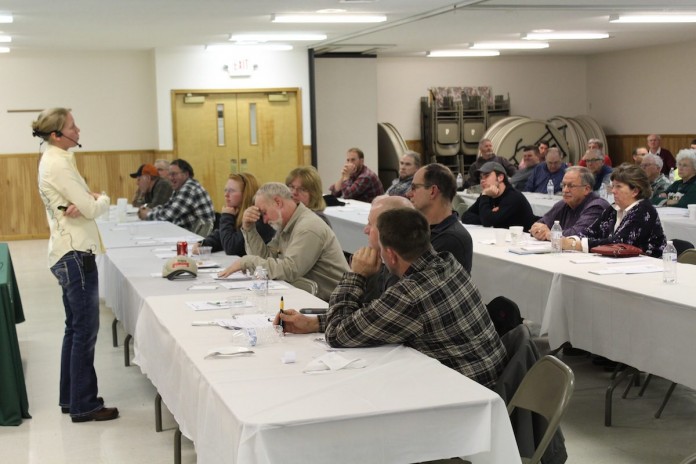OBERLIN, Ohio — Part of producing a good yielding crop is choosing the right seed and the best genetics for your farm. And the other part is managing the growing environment as best you can, so the seeds live up to their potential.
Missy Bauer, a certified crop advisor and an independent crop consultant with B&M Crop Consulting, of Coldwater, Michigan, shared her expertise with northcentral Ohio farmers Feb. 9 in Lorain County.
She explained the factors that can influence soybean yield, and things farmers should be doing to manage the nitrogen in their fields for beans and other crops.
While seed selection is important, as are the treatments applied to that seed, the seed’s performance ultimately comes down to the environment where it’s grown.
“Growth and development are functions of a given variety’s response to its environment,” she said. “As the environment changes, so does plant development.”
Untapped potential
She encouraged the 60-plus growers in attendance to consider the untapped potential of their soybeans.
She said soybean yield boils down to three main components: total number of pods on the plant, number of beans per pod, and weight per bean, or size of the seed.
A big yield factor is plant population. While it might seem that higher populations result in more beans, there’s been a reversal in recent years, Bauer said, and producers are actually decreasing populations, because lower populations result in more pods per plant.
Lowering the population too much, however, will decrease total number of pods and the yield
“It’s a little bit of a numbers game,” she said.
Population factor
The population and row spacing determines how much branching the plants do as they grow. Lower populated fields will usually branch more than high-density fields, which increases yields if those branches also grow mature pods.
She said producers should also consider the height of the plant. Shorter fields often do better than taller ones, partly because taller fields hold more humidity and excess moisture.
Humidity, especially in warm months, is a major stress for the plants. As humidity increases inside the plant canopy, carbon dioxide levels are decreased and plant growth slows.
“The more humidity that we have in the canopy from high populations, we’re going to typically see yields come backward,” she said. “Population has a huge impact on humidity in the canopy.”
Bean stressors. Other stressors include drought, weed issues and cloudy days.
Early stress can reduce the number of pods, mid-season stress can reduce the size of pods or cause beans to abort in the pod, and late-season stress, such as not having significant late-season rain, can affect bean size.
Bauer said the soybean industry could see significant yield improvements if more of the bean’s flowers turned into harvestable pods. Currently, only 25-45 percent make harvestable pods, she said, but the plant needs to overproduce so it can compensate for environmental stressors.
Yield will also go up if producers can find ways to reduce the stressors, which will result in fewer pods being aborted.
Promising trends
Bauer said soybean yield research looks promising, and farmers will likely see some innovations over the next few years.
One could be through the use of approved soybean growth regulators, similar to those being used in the produce industry to produce specific qualities in fruit.
“I expect this to be one of the biggest opportunities or changes over the next several years,” she said. “Keep your eye out on some of these plant growth regulators.”
Bauer is also the Farm Journal associate field agronomist, and she appears on various televised programs. She spoke during an annual event sponsored by Ag Credit Country Mortgages.
Nitrogen management
In a closing discussion, she told farmers about the benefits to managing nitrogen.
Good nitrogen management involves understanding the nitrogen cycle, and understanding which applications might result in early volatilization — or the unwanted vaporization of what is applied.
In addition to whatever sources of nitrogen farmers may add, they also should calculate the nutrient quality of the residue from the previous year’s crop, and remember that it takes nutrients, like nitrogen, in order to break down that residue.
Farmers should remember that crop residue is part of the nutrient cycle, and be sure that their combine or harvest machine spreads the residue evenly — as opposed to strips or piles.
“When you spread your residue with the combine, we don’t want it in strips out there,” she said. “This residue is just like fertilizer.”
She challenged producers to invest in variable rate nitrogen application, because different fields and parts of fields need different amounts. And, applying the right amount usually more than pays for itself, with better tip fill and yield.
“The bottom line is don’t leave the corn hanging,” she said. “When you start to look at the economics … economics on nitrogen are still big.”
Bean basics:
• Soybean growth and development are functions of a given variety’s response to its environment. As the environment changes, so does plant development.
• Soybean branching is a function of environment and genetics.
• If the main growing point has a lot of control over the plant, you will have a straight-line bean. If it has weak control, you will have a bushy bean.
• When sunlight can hit the lower leaves, it puts pressure on the bean to branch out. Once the rows are closed, the branching slows.
• Lower plant density triggers more branching. All beans will branch some in low-plant densities, but bushy beans will do so more quickly and have more branches than straight-line beans.
• Soybeans have three main components of yield: total number of pods, number of beans per pod, and weight or size of bean.
• The upper limit of beans per pod and seed size are genetically determined. Therefore, larger yield increases are usually the result of increased pods per plant.












